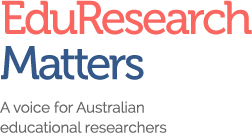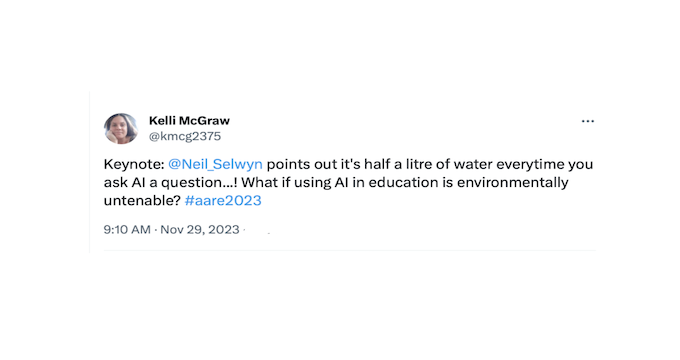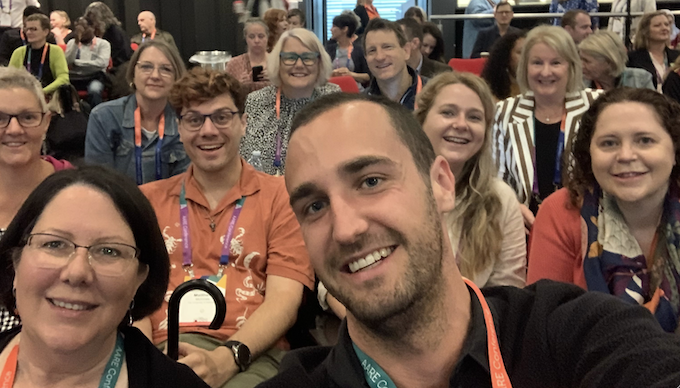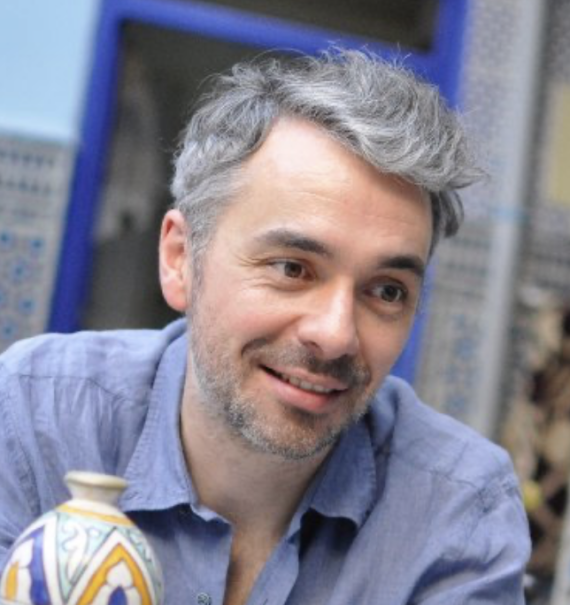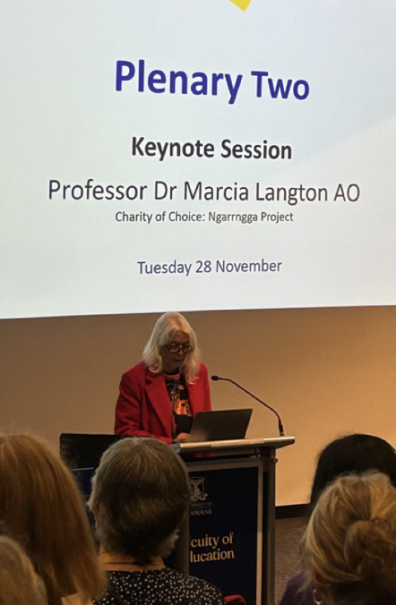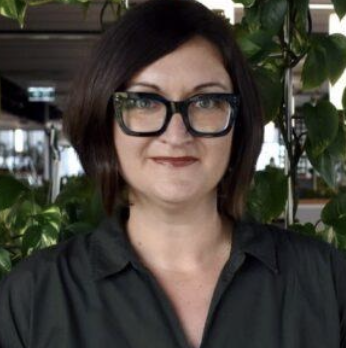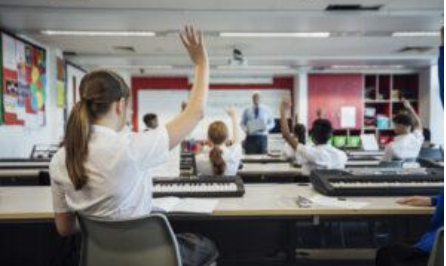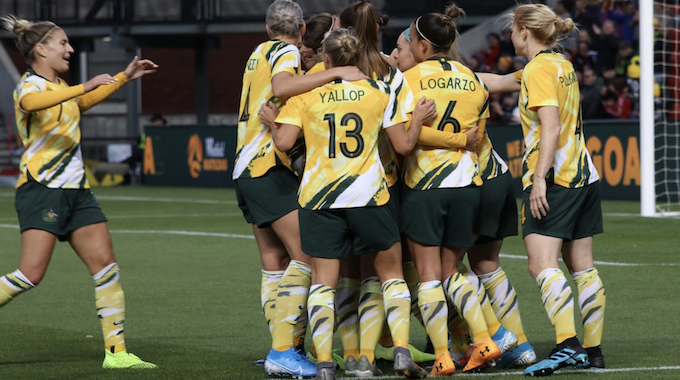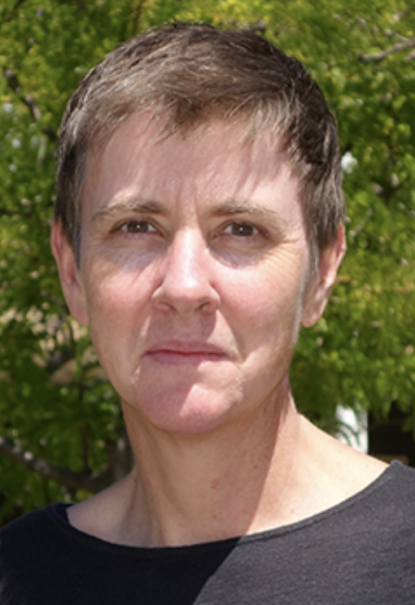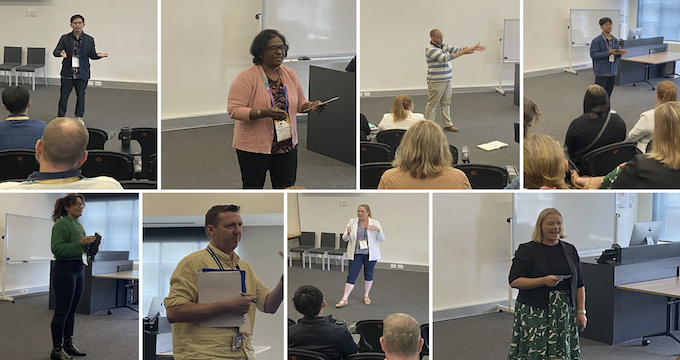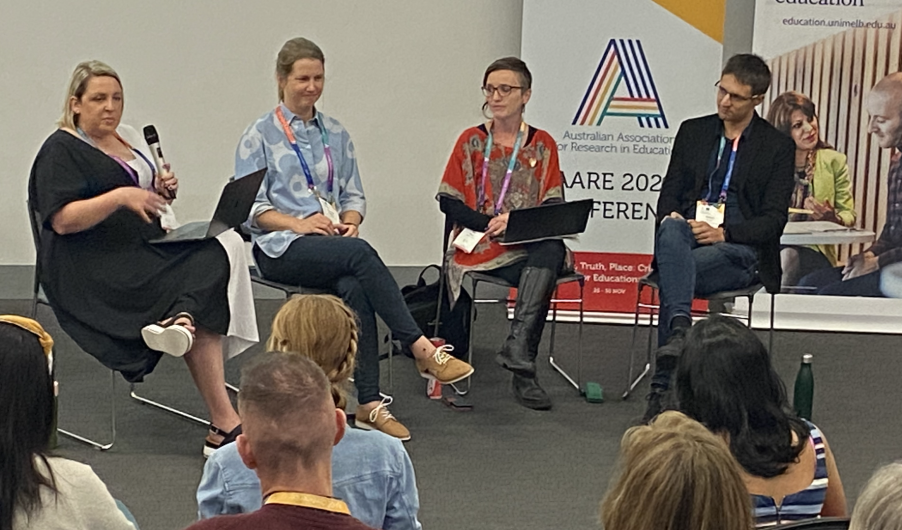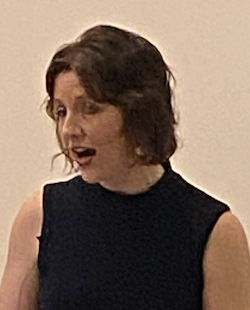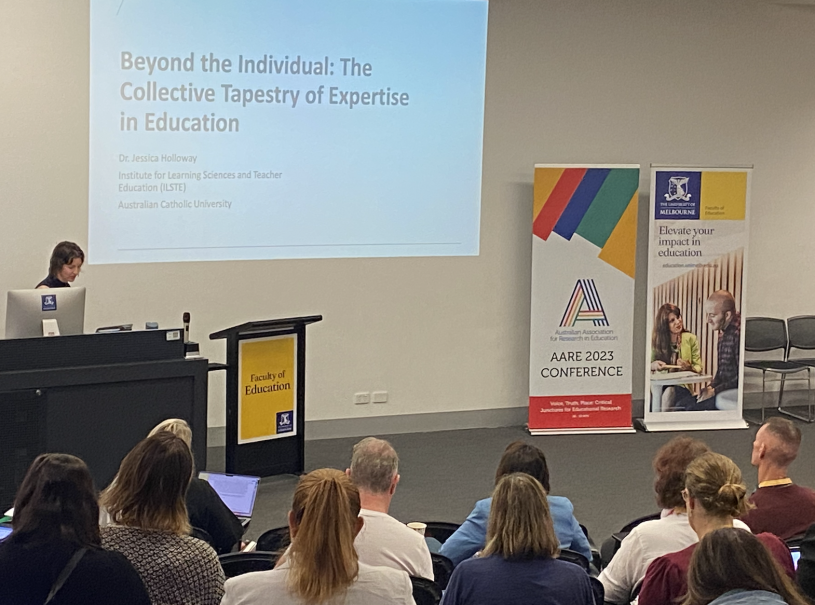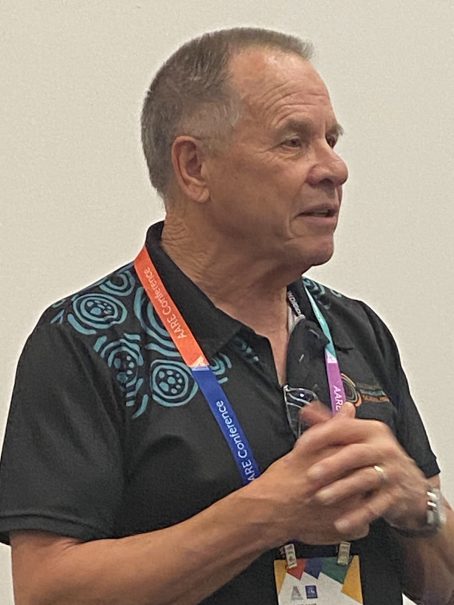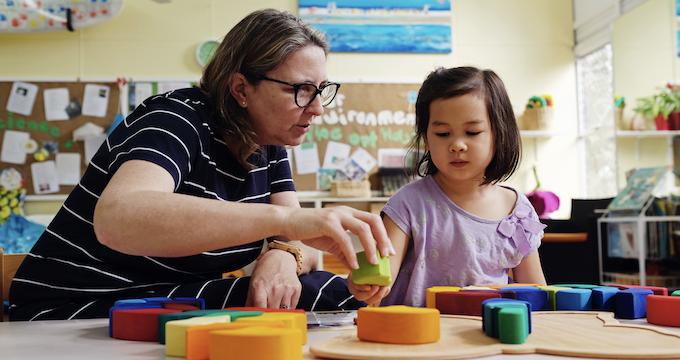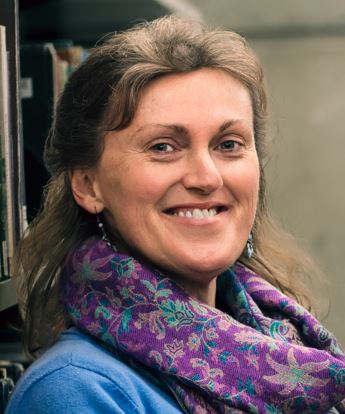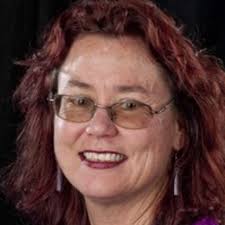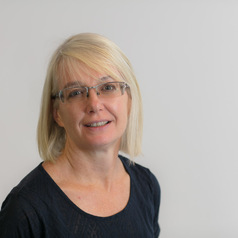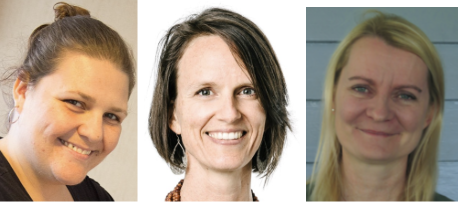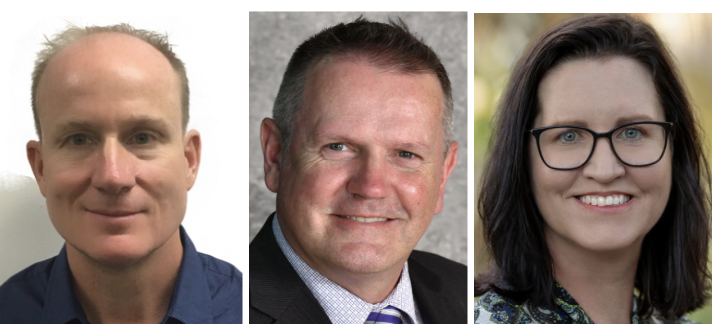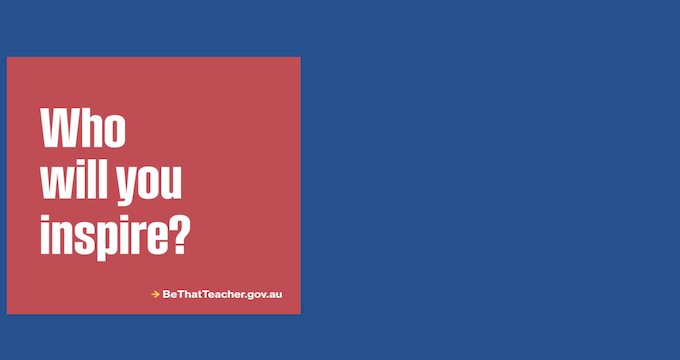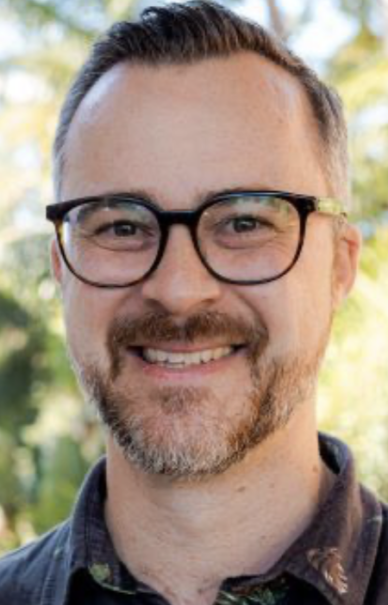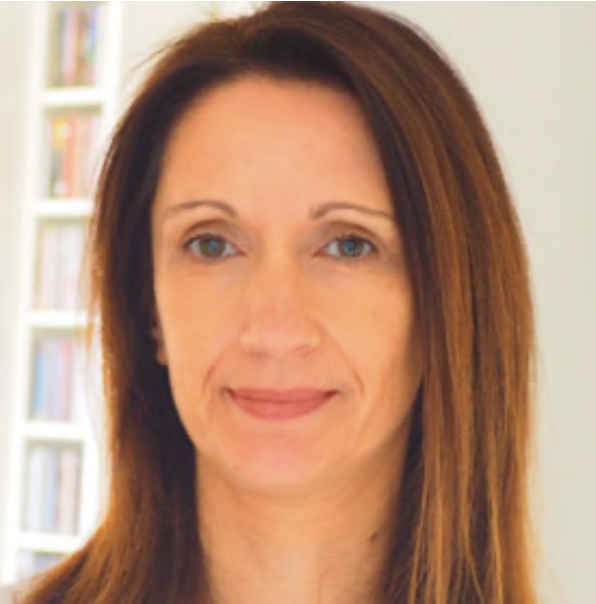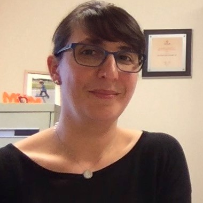Day Four, November 29, 2023.
We will update here during the day so please bookmark this page.
Our EduResearch Matters social accounts are:
- Threads
- Instagram (please post photos and tag them)
- X (formerly Twitter)
Please write, comment, participate about our AARE2023 blog on social media using this hashtag #AARE2023.
Table of contents
Susan Danby delivered the postponed 2022 Radford Lecture. Here is an extract.
Why that now? The ‘everyday’ for children being seen and heard in a digital world
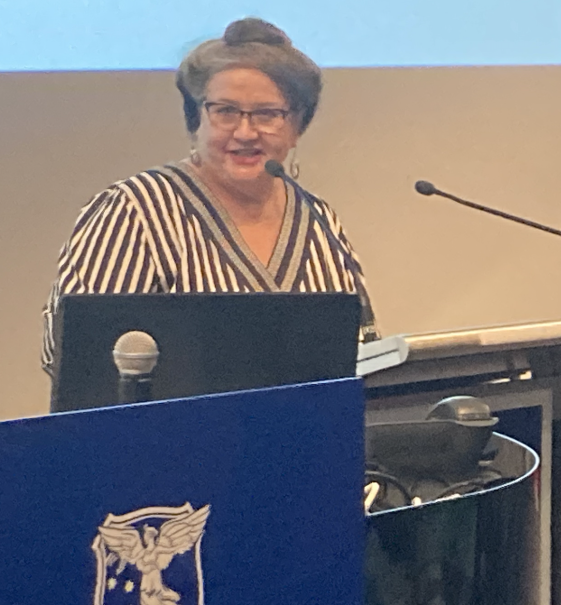
I grew up in a time when children were seen and not heard. As a novice researcher I started investigating how children use language to organise their everyday activities and each other as they navigated their social worlds with peers and adults. Shifting paradigms across research and human rights made possible new ways to see children as agentic members of society.
(Image, left, by Jess Harris)
More recently we are witnessing children’s lives being profoundly changed with the ubiquitous experiences of interacting with new digital worlds unknown by previous generations. I draw on a collection of my research to examine how children attend to their agency as language users across social, educational, and digital contexts.
Focusing on critical junctures of disciplinary paradigms and changing childhood contexts makes possible new research encounters within disciplinary areas and understandings of the complexity of children’s everyday lives.
It is a rare opportunity to be invited to reflect on one’s research. I have approached this presentation today in a way that I hope shows the excitement and curiosity of research and discovering something unknown. I hope that this will inspire us all to be curious, to ask the ethnomethodological question, “why that now”.
I’ll start with three instances of inquiry into young children.
This first is an ad I saw for Kids Helpline. In 1999, I was on a plane to Darwin, when I discovered my new research focus. I just finished my PhD and I had the luxery of flipping through a magazine when I saw this advertisement.
I thought about what my grandfather used to say to me, that “children should be seen and not heard”. I reflected on this when I saw this ad. I became curious about what the children talked about with the counsellors. And how they responded.
This curiosity produced almost a decade of research with Kids Helpline, along with colleagues Carolyn D. Baker, Michael Emmision, and others.
KHL is an organisation dedicated to listening to children and young people. Their mission is “we care, we listen’. It is not to provide help. The way that KHL counsellors open their calls shows a preference to recognising that children and young people have the competence to find their own ways into the call – to disclose their reason for the call.
The second instance involved placing a preservice teacher in a practicum experience. It involves a school, a principal and a classroom. This was when academics visited preservice teachers during their practicum. I was placing a pre service teacher into a repeat practicum – she had experienced a difficult time at her previous school and I wanted her to have a good experience this time at a different school. I had previously visited a classroom where I knew there would be a good fit with the teacher. I contacted the principal to request this student be placed with this teacher. The principal had a different perspective. He would rather the preservice teacher be in a different classroom as the classroom I had suggested was too noisy. He recommended a classroom with a better discipline approach.
In most schooling, children’s voices are presented at the request of, the control of, and the direction, of teachers. Even in the playground. Anything that might be described as noise can signal a lack of proper teacher control, and both children and teacher can be viewed as outside the norms of proper school behaviour.
The third instance involves an 8 year old saying to me, as I picked her up from school: “Being a child is like being a grain of sand on the beach. No-one sees you”
These three accounts -Kids Helpline, the classrooms, the child as an unseen grain of sand – provide mental models of childhoods. Each mental model produces a social construction of a child and, alongside that, a set of assumptions of how to engage with that child. These mental models are deeply held, and thus deeply intractable.
These mental models of children, constructions of childhood, highlight how voice can be legitimised – or not – in and out of school.
Giving voice can be legitimised in various ways. In some schools it’s the sports fields, or in the student club where students have a say about what’s happening in their school. From the very earliest years of early childhood education services through to university graduate programs, voices are legitimised.
As an education discipline, the work of educators has been focused on finding ways to mediate the students’ voices, of mediating their ways of being in the world.
And now we have the digital child. Who is the digital child? Depends on who you ask. From the flight attendant on my flight to Melbourne who realised that her child felt truly confident and social when he was playing games online with his friends, to the grandmother who blamed technology for destroying her relationship with her grandson. To researchers who bring a range of perspectives to understand the lives of digital children, both opportunities and risks. While there is much research being done differently, in regard to respectful engagement with children, there is clearly much work still to be done with our youngest digital citizens.
To conclude, Radford reminds us of some principled ways forward.
The first is that the human dimension can never be diminished or lost.
The second is Radford’s recognition of the value of early childhood. I’m very pleased to have had this opportunity to show how his vision for educational research in early childhood is now being realised.
My wish for AARE is that it continues in the generous spirit that I have found among its members, from my earliest days as a novice researcher to now. It is that spirit that will ensure the success of the Association into the future.
The following post is by Peta White, Deakin University
From the Black Summer comes a new understanding
The Climate Change Education Network (CCEN) has engaged in climate change education (CCE) since the Black Summer bushfires in early 2020. As a group of academics we are committed to CCE, we meet regularly to discuss what is interesting and actionable in our worlds, we share stories and ideas, and work in solidarity building community.
So to build on that, we presented a showcase symposium exploring regenerative leadership, pedagogy adapting to audiences, and prioritising indigenous knowledges and practices. With three presentations and discussant Professor Tracey Bunda, we learned in community.
This symposium enabled us to reflect and collaborate around three initiatives/presentations core to climate change education and to the work of CCEN.
1: Regenerative Leadership reminds us that to lead in this field means we need to guide and collaborate and to practice this regeneratively we must pay attention to our ethical, responsible, ways of being, knowing and doing. This can be especially challenging in neoliberal universities.
2: Pedagogy adapts with our audiences and depending on our underlying philosophies about education. In this presentation we considered the decisions made when we focus on teachers, students, and community. We highlighted pedagogical practices which have successfully engaged learners in climate change education.
3: Prioritising Indigenous knowledges and practices enables us to work together. Relational interactions and collaborations with Indigenous colleagues may not always be possible or easy butwe should encourage collaboration and solidarity in creating our shared future.
Some key enablers to move forward in this practice include learning with Indigenous wisdom through academic literature
- Yarning with Country by Hughes and Barlow
- Listening with Trees, by Arnold, Atchison and McKnight
- Research Through, With and As Storying, by Phillips and Bunda
Many universities host collations of Indigenous led/inclusive citations. This one is from the University of Melbourne: Cite a Blakfella – First Nations in Education
There are many videos and podcasts to educate and share knowledge such as these two:
- The future will be written with the language of the past by Marlikka Prendergast
- Holding the Fire: Episode 2 – Ancient Wisdom with Professor Anne Poelina
Recently the Australian Journal of Environmental Education published a special issue: Indigenous Philosophy in Environmental Education: Relearning How to Love, Feel, Hear, and Live with Place with Guest Editors: Anne Poelina, Yin Paradies, Sandra Wooltorton, Mindy Blaise, Libby Jackson-Barratt, and Laurie Guimond – open access
This special issue was launched at the Australian Association for Environmental Education Research Symposium – as the opening panel presentation with presentations from the editorial board and some authors.
Finally, discussant Professor Tracey Bunda reflected with us and then lead a whole group conversation and asked us to consider the concept of kin in Indigenous Australian ontologies: ways to embrace human and non-human beings and the recent and ongoing ravages of colonisation. She taught us by showing us and grouping us in the room what kin means. She gave an example, using colleague Joseph Ferguson from Deakin, and suggested an example totem – the wombat and grey ash.
We work and learn alongside our Indigenous academic colleagues prioritising their contributions while choosing (hoping) to not add to their overwhelming cultural load. We value learning and living in place practising caring with, and for, Country.
The following post is by Naomi Barnes, QUT
Funding: how do we think it should change?
In a wonderfully provocative policy and politics session presenters Tim Delaney, Naomi Barnes (with Anna Hogan), Glenn Savage and Matthew P. Sinclair challenged the audience to think differently about school funding.
First up, Delaney discussed how he has been working to decolonize the literature review when discussing the foundational document for contemporary school funding settlement and sedimentation, The 1973 Karmel Report. The Report, released under the Whitlam government, set the stage for school funding, opening the door to economically rational logics of the Hawke and Keating years. Drawing on work by scholars who have challenged the Western-centric logic of the literature review, such as Lauren Tynan and Michelle Bishop, Delaney first thought about how to lay the foundations for his policy analysis of school funding through reviewing literature that asks how public education can be imagined differently and as an alternative to the racial capitalism embedded in the current structures.
Barnes and Hogan challenged the ‘school choice’ discourses that take up room, both the discourses that support and challenge the funding mechanism in Australia, but specifically Queensland semi-selective public schools. Their research focused on the people making the decisions — middle class women. Barnes argued that it is absurd to only make arguments that consider the logic of data when discussing school choice because people make decisions with their emotions, not just their heads. To separate the head from the body is to walk the very problematic pathway of categorising the school chooser as irrational. This is a well worn categorisation of women that we see in work around hysteria at the turn of the 20th century, and as feminist scholars we need to question how work associated with school choice categorises the mothers making the choices.
Finally Savage and Sinclair suggested the the solution to equitable school funding was to establish a national funding regulation and quality control organisation. Positioned as a radical idea, the discussion it (intentionally) animated was that it did not go far enough. Such a body would not shift the current inequalities in Australian education funding so would probably be very well received by all schooling sectors, with the Catholic and Independent schooling systems being left unchallenged. The challenge to federalism, Savage argued, would be to sweeten the deal with more funding. What do you think?
The following post is by Steven Kolber, University of Melbourne
Teacher identity: on knowing, being, doing
Empowering teachers is a process formed out of deep identity work where teachers come to know themselves and their peers.
Theoretically, social network theory, Neo-Capital Theories, alongside Social Capital as a trio of theories to explore teachers’ resources for teaching. Social capital comes out of relationships and these connections are formed mostly around similarity between teachers and their location and role within the school.
Some have proposed that social capital can and should be a focus for teachers’ professional learning. This idea was explored through the lens of Quality Teaching Rounds (QTR) which are professional learning communities (PLC) that focus on teacher peer observations (active control) or the PD ‘as usual’ (waitlist control).
Pre and post interviews of the nature of the relationships between teachers in PLC groups were the focus of this PhD study. The findings, with caveats around them being not statistically significant, and small sample size were an increase in a rise in the four elements of social capital studied. These small shifts might mean an increase in only contacting one person about professional advice before the study, and heading towards two afterwards.
The process of engaging with QTR as a form of ‘forced’ or ‘required’ collaboration had a small positive outcome on teachers’ development of social capital through relational closeness.
Shifting to the online space, Twitter was explored as a site where teachers can come to become agentic and empowered.
The nature of professional learning quality of delivery being hodge podge as it is, exploring Communities of Practice (CoP) both online and within schools seems like an important gap filling activity. Social Learning Spaces by Wenger are different to CoPs where learners may drop in and drop out of the learning spaces. The engagement with these spaces caused participants’ edge of learning to be pushed.
The role of the leader to organise Twitter (now X) was noted as unpaid and requiring significant investment for those organising and running these groups, which function rather like loosely formed SIGs.
‘PD in the palm of your hand’ saw teachers finding meaning and usefulness for accessing these social media services. Mentoring, relationality and sharing of resources and support from other teachers are part of the process and practice that proved important.
The #edureading academic reading group was showcased as a space where teachers are engaged with research. This was mentioned alongside the Monash Q project which is, and has, explored the research use of teachers in a similar space to this group.
Discussion following the session raised the question of the nature of professional learning not catching up to the innovative and exciting use of learning occurring online. The key regulatory bodies need to catch up to the realities on the ground (or in the air) around what the modern face of professional learning. Teacher education similarly could consider (not that it doesn’t already) more broadly the inclusion of additive learning tools through social learning spaces.
Moving from online and relational identities, Nashid provided the lens of feeling “othered” or “privileged” based on factors like language, race, culture, gender, or intersections. Employment experiences of English language teachers, from a migrant and second-language background.
These teachers experienced hiring discrimination alongside imposters syndrome, fear and other negative feelings. This is problematic and challenging considering we exist within a National teacher shortage, where respondents note ‘no one would give me the job as an English teacher’, as a result of accented or ‘Non-standard’ English. The necessity of having a qualification from a prestigious Australian university to even be considered for an interview was noted, and the suggestion to develop a pseudonym or false name on resumes to avoid discriminatory and exclusionary practices.
Teachers being required to complete The International English Language Testing System (IELTS) tests to prove their language proficiency after completing two post-graduate degrees was a clear anecdotal example of institutional racism being enacted through faceless policies.
Despite these negative examples, reflexivity and agency were possible to emerge from the participating teachers. Noting that clear speech regardless of accent was what was required by their students. The ‘Non-native English Speaking Teachers’ (NNESTs) presented showed a wealth of experience and insights as teachers which was largely ignored due to brief ‘othering’ and the practice of institutionally racist policies and structures.
Teacher identity development and empowerment were a clear focus throughout the sessions, moving from knowledge developed within the field and how this can be used to inform policy, professional learning and the awareness of identities within the space.
Sessions:
Capitalising on collegiality: Exploring the capacity of Quality
Teaching Rounds to build teachers’ social capital Brooke Rosser, University of Newcastle
Finding your voice in an online Twitter place: professional learning, networks and support for teachers at all career stages
Bernadette Mercieca, Our Lady of Mercy College Heidelberg;
Jacquie McDonald, USQ
“No one would give me that job in Australia”:
When professional identities intersect with how teachers look, speak and where they come from
Nashid Nigar, Monash University
The following post is by Kalervo Gulson of the University of Sydney.
Resetting the education research agenda

Why do we do educational research? What would it mean to reset research agendas? And what is meaningful education research?
(left, Neil Selwyn delivering the keynote)
In a keynote address for AARE, Monash University’s Professor Neil Selwyn, proposed that these questions could, and indeed, should guide our field to retain a relevance in creating and shaping the knowledge that will matter: the knowledge to deal with the climate crisis, the knowledge to manage post- and future pandemic life, the knowledge to handle the challenges of artificial intelligence.
Selwyn proposed that the question of what works and why is the question that animates much of the field of educational research.
But he said it is the wrong question for education research – the most impactful research is being done outside of the academy, where our governments listen to new kinds of authoritative voices, from the OECD to global consultancies.
What then remains for education research? For Selwyn, the key offering, the ‘unique selling point’ should be to provide responses to contextually complex questions that provide insights that are different from these other external voices. And that all education researchers should embrace their own fields, but also find ways of speaking to what he called polycrises of the present and future. Selwyn proposed that , ‘our job is to say why things are complicated, and how these complicated things can be navigated’.
Selwyn illustrated this by highlighting the different ways in which artificial intelligence in education could be investigated. While the normal way is to look at the opportunities and harms of AI in teaching and learning, Selwyn pointed out that there are larger and more pressing questions that could also be asked. These include questions about the social sustainability of using technologies in education that have been demonstrated in other fields to be discriminatory; and questions about the climate cost of using automated technologies.
How would we go about undertaking Selwyn’s resetting of the research agenda?
The proposal has four areas.
First, to embrace the vulnerabilities of not knowing, an embracing of discomfort and uncertainty as a precondition for scholarship.
Second, to be open to the difficulties of navigating the necessary interdisciplinarity that is attached to addressing polycrises. That we need multiple voices in these conversations.
Third, to reassess the redemptive project of formal education, and to cast a keen eye on whether formal education as currently constituted can address the problems of the future.
Fourth – and maybe most importantly – not to lose hope.
These four areas are by no means straightforward to address or enact. But Selwyn made a compelling point that education research is in a unique position to be relevant. And more forcefully, the polycrises in front of us really provide little option but to begin to not just think but act on resetting our research agenda.

